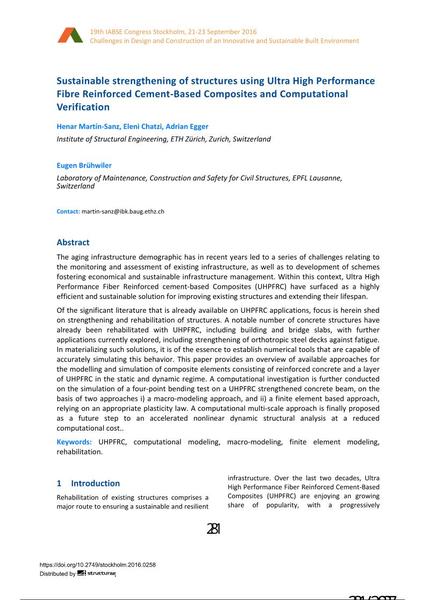Sustainable strengthening of structures using Ultra High Performance Fibre Reinforced Cement-Based Composites and Computational Verification

|
|
|||||||||||
Détails bibliographiques
| Auteur(s): |
Henar Martin-Sanz
(Institute of Structural Engineering, ETH Zürich, Zurich, Switzerland)
Adrian Egger (Institute of Structural Engineering, ETH Zürich, Zurich, Switzerland) Eleni Chatzi (Institute of Structural Engineering, ETH Zürich, Zurich, Switzerland) Eugen Brühwiler |
||||
|---|---|---|---|---|---|
| Médium: | papier de conférence | ||||
| Langue(s): | anglais | ||||
| Conférence: | IABSE Congress: Challenges in Design and Construction of an Innovative and Sustainable Built Environment, Stockholm, Sweden, 21-23 September 2016 | ||||
| Publié dans: | IABSE Congress Stockholm, 2016 | ||||
|
|||||
| Page(s): | 281-289 | ||||
| Nombre total de pages (du PDF): | 9 | ||||
| Année: | 2016 | ||||
| DOI: | 10.2749/stockholm.2016.0258 | ||||
| Abstrait: |
The aging infrastructure demographic has in recent years led to a series of challenges relating to the monitoring and assessment of existing infrastructure, as well as to development of schemes fostering economical and sustainable infrastructure management. Within this context, Ultra High Performance Fiber Reinforced cement-based Composites (UHPFRC) have surfaced as a highly efficient and sustainable solution for improving existing structures and extending their lifespan. Of the significant literature that is already available on UHPFRC applications, focus is herein shed on strengthening and rehabilitation of structures. A notable number of concrete structures have already been rehabilitated with UHPFRC, including building and bridge slabs, with further applications currently explored, including strengthening of orthotropic steel decks against fatigue. In materializing such solutions, it is of the essence to establish numerical tools that are capable of accurately simulating this behavior. This paper provides an overview of available approaches for the modelling and simulation of composite elements consisting of reinforced concrete and a layer of UHPFRC in the static and dynamic regime. A computational investigation is further conducted on the simulation of a four-point bending test on a UHPFRC strengthened concrete beam, on the basis of two approaches i) a macro-modeling approach, and ii) a finite element based approach, relying on an appropriate plasticity law. A computational multi-scale approach is finally proposed as a future step to an accelerated nonlinear dynamic structural analysis at a reduced computational cost.. |
||||
